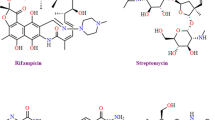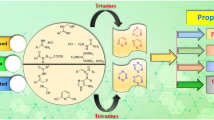Abstract
New isatinic hydrazone Schiff-base ligands, namely furan-2-carboxylic acid (2-oxo-1,2-dihydro-indol-3-ylidene)-hydrazide (L1), thiophene-2-carboxylic acid (2-oxo-1,2-dihydro-indol-3-ylidene)-hydrazide (L2) and 2-(pyridine-2-yl-hydrazono)-1,2-dihydro-indol-3-one) (L3) are reported. The ligands were prepared by the condensation of furan-2-carboxylic acid hydrazide (L1), thiophene-2-carboxylic acid hydrazide (L2), and 2-hydrazino pyridine (L3) with isatine. Monomeric complexes were prepared from the reaction of the corresponding metal chloride with the ligands. The ligands and their nine new complexes of the general formulae [M(Ln)2]Cl2 [where M = Co(II), Zn(II) and Cd(II); n = L1, L2 and L3] were characterised by spectroscopic methods (FTIR, UV–Vis, 1H, 13C NMR), elemental analysis, metal content, magnetic measurement and molar conductance. These studies revealed the formation of six coordinate complexes, in which the geometry about metal atom is a distorted octahedral. Biological activity of the ligands and their metal complexes against Gram-positive bacterial strain Bacillus (G+) and Gram-negative bacteria Ecoli (G−) are evaluated. The effects of prepared compounds depend on the type of tested bacteria. It is clear that the ligands and their metal complexes have a potential effect on the Gram-positive (G+) and Gram-negative (G−) strains of the tested bacteria.


Similar content being viewed by others
References
Al-Dulaimi JS, Al-Jeboori MJ, Issa IO (2011) Formation of binuclear metal complexes with multidentate schiff-base oxime ligand: synthesis and spectral investigation. J Ibn Al-Haitham Pure Appl Sci 24(2):205–218
Ali MA, Mirza AH, Bakar HJ, Bernhardt PV (2011) Preparation and structural characterization of nickel(II), cobalt(II), zinc(II) and tin(IV) complexes of the isatin Schiff bases of S-methyl and S-benzyldithiocarbazates. Polyhedron 30(4):556–564
Al-Jeboori MJ, Abdul Rahman AA, Atia S (2005) Synthesis and spectral studies on cobalt(II), nickel(II), copper(II), palladium(II), platinum(II, IV), zinc(II), cadmium(II) and mercury(II) complexes of (1,2-diaminoethane-N, N-bis(2-butylidine-3onedioxime). J Ibn Al-Haitham Pure Appl Sci 18(2):51
Al-Jeboori MJ, Al-Dujaili AH, Al-Janabi A (2009) Coordination of carbonyl oxygen in the complexes of polymeric N-crotonyl-2-hydroxyphenylazomethine. Transition Met Chem 34(1):109–113
Al-Jeboori MJ, Al-Tawel HH, Ahmad RM (2010) New metal complexes of N2S2 tetradentate ligands: synthesis and spectral studies. Inorg Chim Acta 363(6):1301–1305
Aly MM, Baghlaf AO, Ganji NS (1985) Linkage isomerism of the oximato group: the characterization of some mono- and binuclear square planar nickel(II) complexes of vicinal oxime-imine ligands. Polyhedron 4(7):1301–1309
Chohan ZH, Pervez H, Khan KM, Rauf A, Maharvi GM, Supuran CT (2004) Antifungal Cobalt(II), Copper(II), Nickel(II) and Zinc(II) Complexes of Furanyl-, Thiophenyl-, Pyrrolyl-, Salicylyl- and Pyridyl-derived Cephalexins. J Enzyme Inhib Med Chem 19(1):85–90
Cohen, M.D., Flavian, S., Topochemistry. Part XXIV. The luminescence properties of N-salicylideneaniline and related anils in solution. Journal of the Chemical Society B: Physical Organic, 1967: p. 317–321
El-Sonbati AZ, El-Bindary AA, Al-Sarawy AA (2002) Stereochemistry of new nitrogen containing heterocyclic aldehyde. IX. Spectroscopic studies on novel mixed-ligand complexes of Rh(III). Spectrochim Acta Part A Mol Biomol Spectrosc 58(12):2771–2778
Figgis BN (1967) Introduction to ligand fields. Wiley, New York
Geary WJ (1971) The use of conductivity measurements in organic solvents for the characterisation of coordination compounds. Coord Chem Rev 7(1):81–122
Hoshino N (1998) Liquid crystal properties of metal-salicylaldimine complexes.: chemical modifications towards lower symmetry. Coord Chem Rev 174(1):77–108
Larson EJ, Pecoraro VL (1991) The peroxide-dependent.mu.2-O bond formation of manganese complex [Mn(IV)SALPN(O)]2. J Am Chem Soc 113(10):3810–3818
Lever AB (1984) Inorganic Electronic Spectroscopy, 2nd edn. Elsevier, New York
Livingstone SE, Mayfield JH, Moore DS (1975) Thio derivatives of β-diketones and their metal chelates. XX. Magnetic moments of some ruthenium(III) chelates of fluorinated Monothio-β-diketones. Aust J Chem 28(11):2531–2533
Menger MF, Gold Smith DJ, Manden L (1975) Organic chemistry: a concise approach, 2nd edn. WA Benjamin, p 555
Nakomoto K (1996) Infrared spectra of inorganic and coordination compounds, 4th edn. Wiely, New York
Nasman OSM (2008) N2S2-Donor macrocycles with some transition metal ions: synthesis and characterization. J Phosphorus Sulfur Silicon Relat Elem 183(7):1541–1551
Rahman A, Choudhary M, Thomsen W (2001) Bioassay techniques for drug development. Harwood Academic, Amsterdam, The Netherlands, pp 15–18
Ramade I, Kahn O, Jeannin Y, Robert F (1997) Design and magnetic properties of a magnetically isolated GdIIICuII Pair. Crystal structures of [Gd(hfa)3Cu(salen)], [Y(hfa)3Cu(salen)], [Gd(hfa)3Cu(salen)(Meim)], and [La(hfa)3(H2O)Cu(salen)] [hfa = Hexafluoroacetylacetonato, salen = N, N′-Ethylenebis(salicylideneaminato), Meim = 1-Methylimidazole]. Inorg Chem 36(5):930–936
Shi L, Mao W, Yang Y, Zhu H (2009) Synthesis, characterization, and biological activity of a Schiff-base Zn(II) complex. J Coord Chem 62(21):3471–3477
Silverstein RM (2005) Spectrometric identification of organic compounds. 7th edn: Wiley, New York
Singh DP, Malik V, Kumar K, Sharma C, Aneja KR (2010) Macrocyclic metal complexes derived from 2,6-diaminopyridine and isatin with their antibacterial and spectroscopic studies. Spectrochim Acta Part A 76(1):45–49
Tarafder MTH, Chew K, Crouse KA, Ali AM, Yamin BM, Fun HK (2002) Synthesis and characterization of Cu(II), Ni(II) and Zn(II) metal complexes of bidentate NS isomeric Schiff bases derived from S-methyldithiocarbazate (SMDTC): bioactivity of the bidentate NS isomeric Schiff bases, some of their Cu(II), Ni(II) and Zn(II) complexes and the X-ray structure of the bis[S-methyl-β-N-(2-furyl-methyl)methylenedithiocarbazato]zinc(II) complex. Polyhedron 21(27–28):2683–2690
Zhao J, Zhao B, Liu J, Xu W, Wang Z (2001) Spectroscopy study on the photochromism of Schiff Bases N, N′-bis(salicylidene)-1,2-diaminoethane and N, N′-bis(salicylidene)-1,6-hexanediamine. Spectrochim Acta Part A Mol Biomol Spectrosc 57(1):149–154
Author information
Authors and Affiliations
Corresponding author
Electronic supplementary material
Below is the link to the electronic supplementary material.
Rights and permissions
About this article
Cite this article
Yousif, E.I., Ahmed, R.M., Hasan, H.A. et al. Metal Complexes of Heterocyclic Hydrazone Schiff-Bases: Preparation, Spectral Characterisation and Biological Study. Iran J Sci Technol Trans Sci 41, 103–109 (2017). https://doi.org/10.1007/s40995-017-0187-z
Received:
Accepted:
Published:
Issue Date:
DOI: https://doi.org/10.1007/s40995-017-0187-z




